Research Report: Accounting for Carbon Emission Allowances (ACC5AAI)
VerifiedAdded on 2022/10/01
|17
|5608
|17
Report
AI Summary
This report examines the critical area of carbon emission accounting, focusing on the challenges and complexities faced by companies. It investigates accounting methods for carbon emission allowances within the context of international trading schemes. The research encompasses a literature review analyzing trading schemes in developed and developing countries, and the application of positive accounting theory to corporate accounting policies. Furthermore, it analyzes financial information and disclosures related to carbon emission allowances in the material industry, specifically focusing on Australian and European Union companies. The report explores the accounting measurement of carbon emission allowances and discusses findings within a theoretical framework, addressing the lack of a specific IFRS standard and the resulting inconsistencies in accounting practices. The research aims to provide insights into the accounting treatment of carbon emissions and its impact on financial reporting.
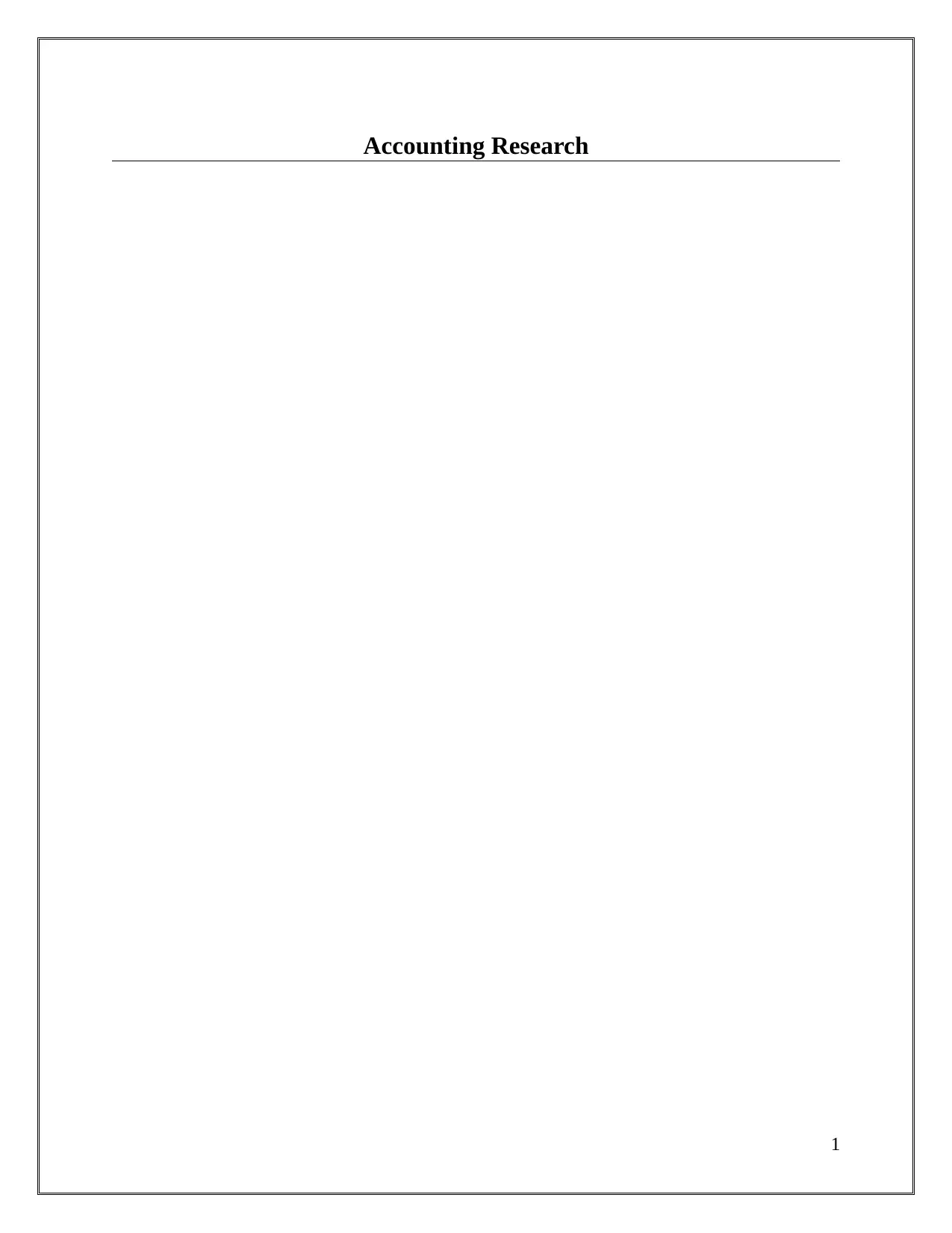
Accounting Research
1
1
Paraphrase This Document
Need a fresh take? Get an instant paraphrase of this document with our AI Paraphraser
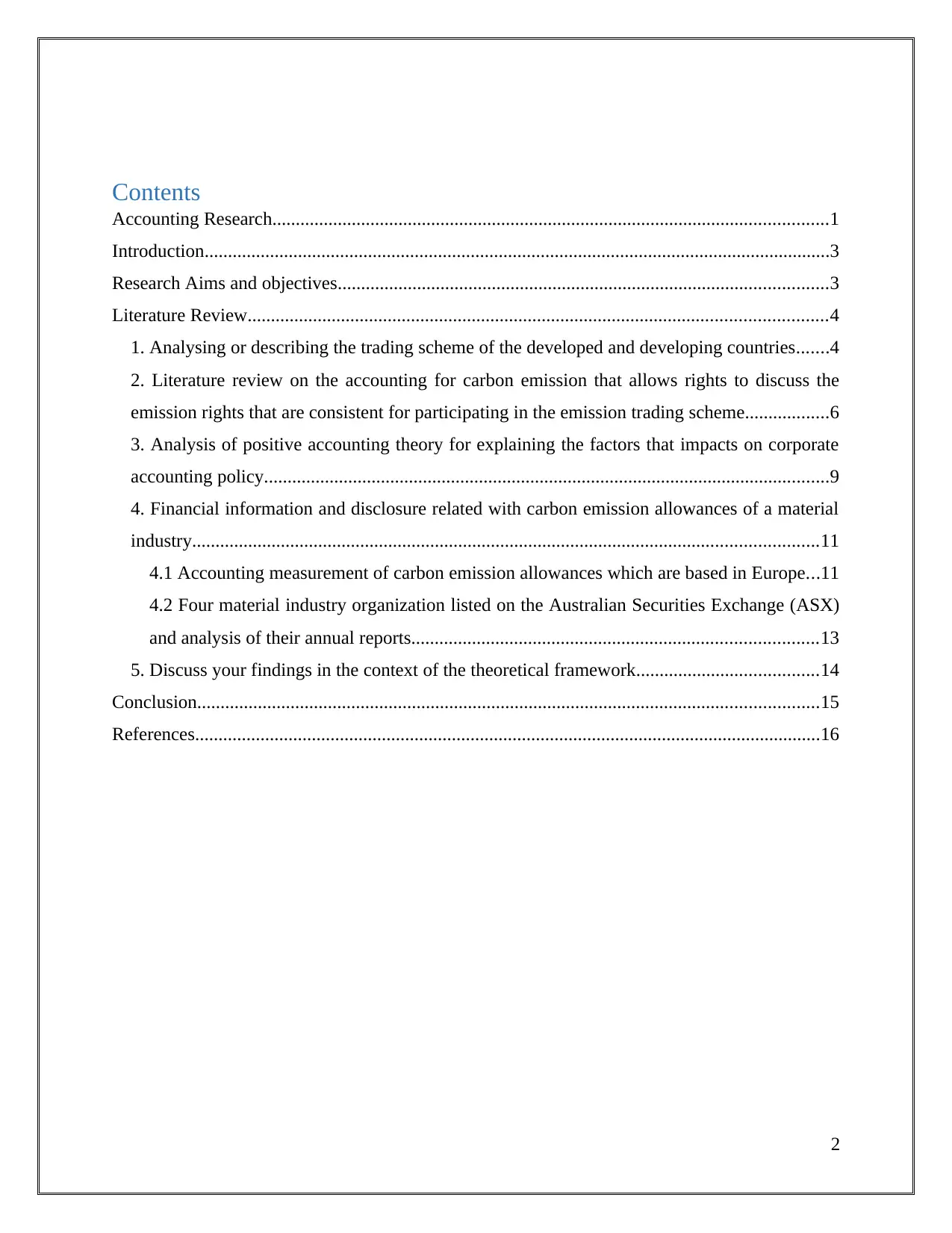
Contents
Accounting Research.......................................................................................................................1
Introduction......................................................................................................................................3
Research Aims and objectives.........................................................................................................3
Literature Review............................................................................................................................4
1. Analysing or describing the trading scheme of the developed and developing countries.......4
2. Literature review on the accounting for carbon emission that allows rights to discuss the
emission rights that are consistent for participating in the emission trading scheme..................6
3. Analysis of positive accounting theory for explaining the factors that impacts on corporate
accounting policy.........................................................................................................................9
4. Financial information and disclosure related with carbon emission allowances of a material
industry......................................................................................................................................11
4.1 Accounting measurement of carbon emission allowances which are based in Europe...11
4.2 Four material industry organization listed on the Australian Securities Exchange (ASX)
and analysis of their annual reports.......................................................................................13
5. Discuss your findings in the context of the theoretical framework.......................................14
Conclusion.....................................................................................................................................15
References......................................................................................................................................16
2
Accounting Research.......................................................................................................................1
Introduction......................................................................................................................................3
Research Aims and objectives.........................................................................................................3
Literature Review............................................................................................................................4
1. Analysing or describing the trading scheme of the developed and developing countries.......4
2. Literature review on the accounting for carbon emission that allows rights to discuss the
emission rights that are consistent for participating in the emission trading scheme..................6
3. Analysis of positive accounting theory for explaining the factors that impacts on corporate
accounting policy.........................................................................................................................9
4. Financial information and disclosure related with carbon emission allowances of a material
industry......................................................................................................................................11
4.1 Accounting measurement of carbon emission allowances which are based in Europe...11
4.2 Four material industry organization listed on the Australian Securities Exchange (ASX)
and analysis of their annual reports.......................................................................................13
5. Discuss your findings in the context of the theoretical framework.......................................14
Conclusion.....................................................................................................................................15
References......................................................................................................................................16
2
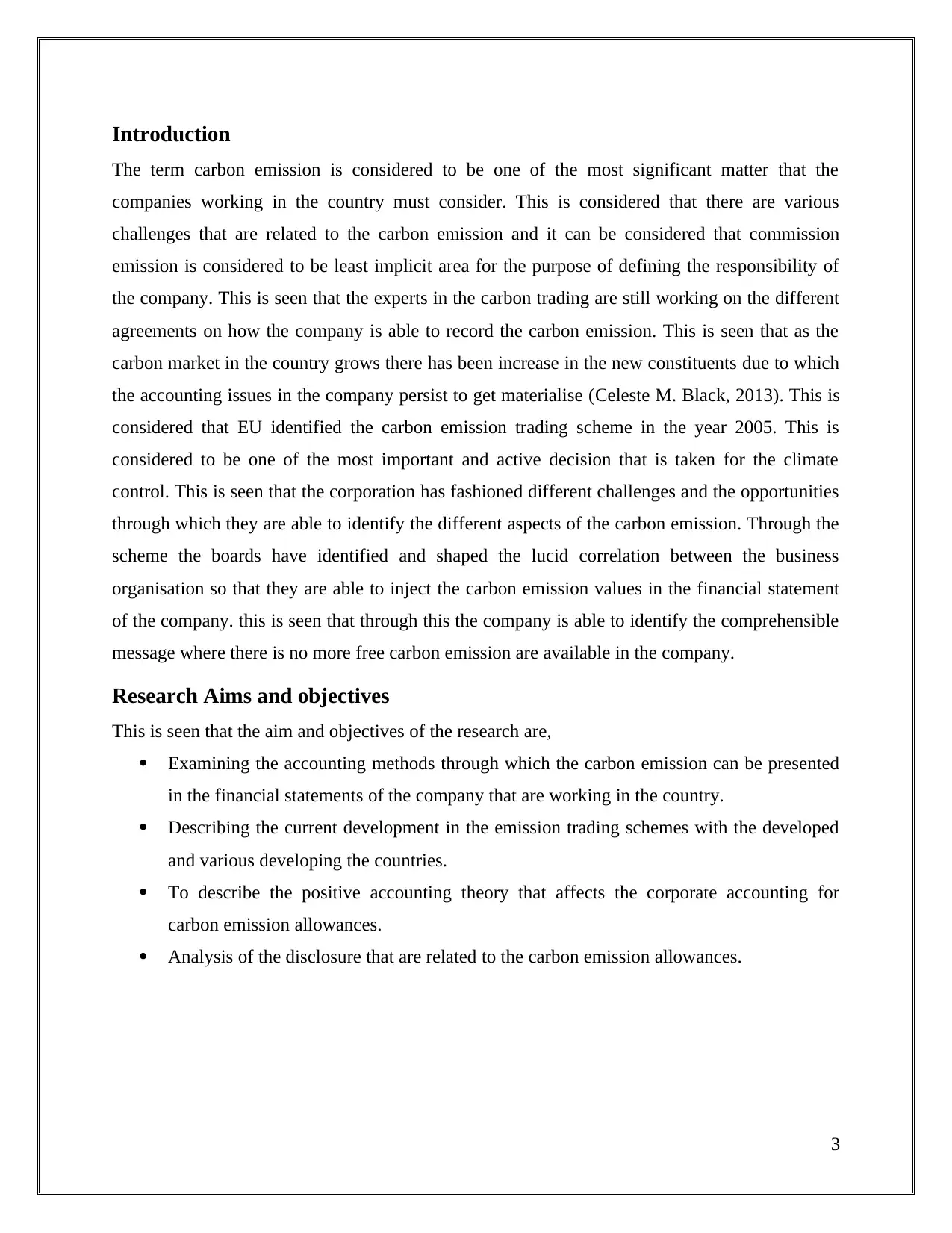
Introduction
The term carbon emission is considered to be one of the most significant matter that the
companies working in the country must consider. This is considered that there are various
challenges that are related to the carbon emission and it can be considered that commission
emission is considered to be least implicit area for the purpose of defining the responsibility of
the company. This is seen that the experts in the carbon trading are still working on the different
agreements on how the company is able to record the carbon emission. This is seen that as the
carbon market in the country grows there has been increase in the new constituents due to which
the accounting issues in the company persist to get materialise (Celeste M. Black, 2013). This is
considered that EU identified the carbon emission trading scheme in the year 2005. This is
considered to be one of the most important and active decision that is taken for the climate
control. This is seen that the corporation has fashioned different challenges and the opportunities
through which they are able to identify the different aspects of the carbon emission. Through the
scheme the boards have identified and shaped the lucid correlation between the business
organisation so that they are able to inject the carbon emission values in the financial statement
of the company. this is seen that through this the company is able to identify the comprehensible
message where there is no more free carbon emission are available in the company.
Research Aims and objectives
This is seen that the aim and objectives of the research are,
Examining the accounting methods through which the carbon emission can be presented
in the financial statements of the company that are working in the country.
Describing the current development in the emission trading schemes with the developed
and various developing the countries.
To describe the positive accounting theory that affects the corporate accounting for
carbon emission allowances.
Analysis of the disclosure that are related to the carbon emission allowances.
3
The term carbon emission is considered to be one of the most significant matter that the
companies working in the country must consider. This is considered that there are various
challenges that are related to the carbon emission and it can be considered that commission
emission is considered to be least implicit area for the purpose of defining the responsibility of
the company. This is seen that the experts in the carbon trading are still working on the different
agreements on how the company is able to record the carbon emission. This is seen that as the
carbon market in the country grows there has been increase in the new constituents due to which
the accounting issues in the company persist to get materialise (Celeste M. Black, 2013). This is
considered that EU identified the carbon emission trading scheme in the year 2005. This is
considered to be one of the most important and active decision that is taken for the climate
control. This is seen that the corporation has fashioned different challenges and the opportunities
through which they are able to identify the different aspects of the carbon emission. Through the
scheme the boards have identified and shaped the lucid correlation between the business
organisation so that they are able to inject the carbon emission values in the financial statement
of the company. this is seen that through this the company is able to identify the comprehensible
message where there is no more free carbon emission are available in the company.
Research Aims and objectives
This is seen that the aim and objectives of the research are,
Examining the accounting methods through which the carbon emission can be presented
in the financial statements of the company that are working in the country.
Describing the current development in the emission trading schemes with the developed
and various developing the countries.
To describe the positive accounting theory that affects the corporate accounting for
carbon emission allowances.
Analysis of the disclosure that are related to the carbon emission allowances.
3
⊘ This is a preview!⊘
Do you want full access?
Subscribe today to unlock all pages.

Trusted by 1+ million students worldwide
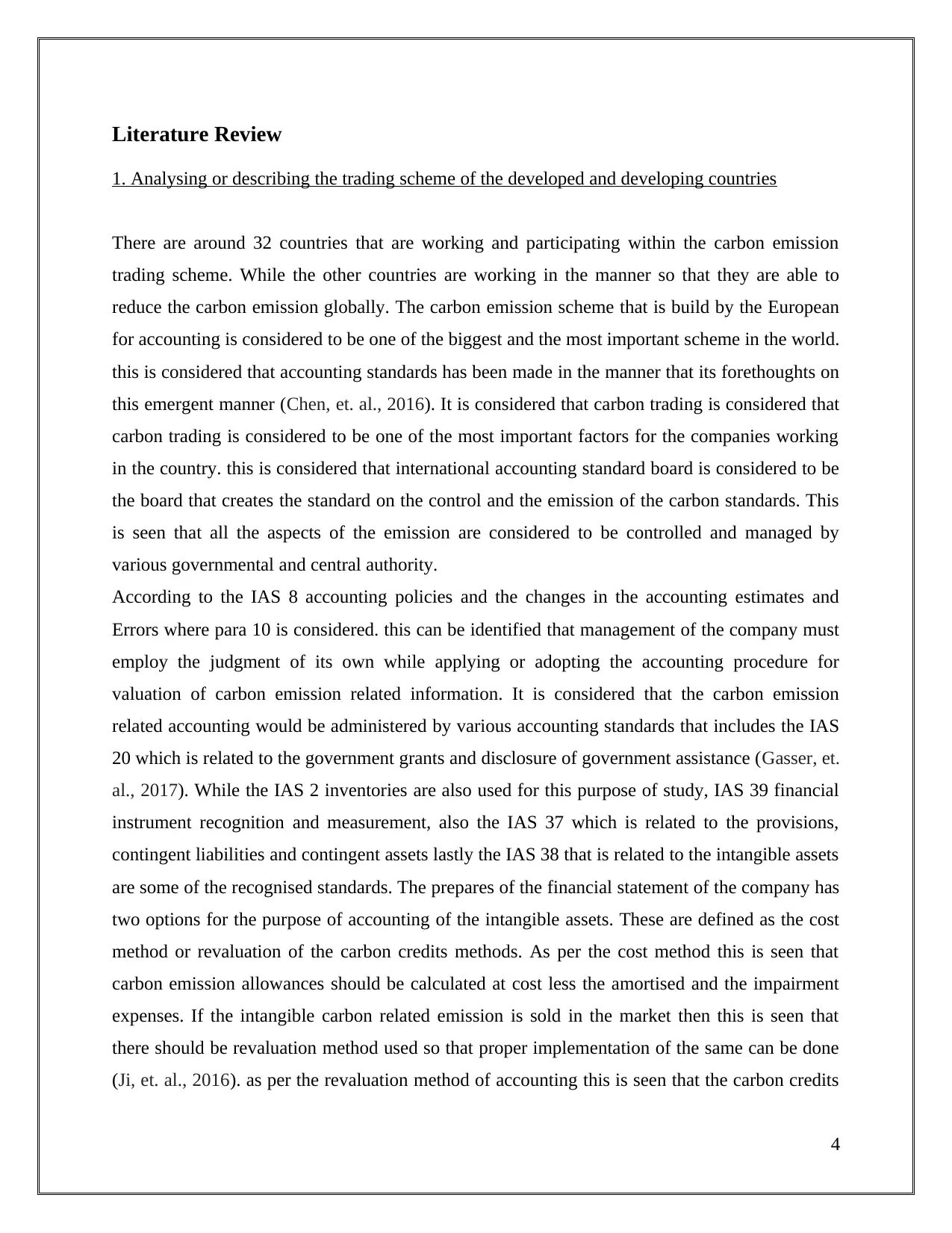
Literature Review
1. Analysing or describing the trading scheme of the developed and developing countries
There are around 32 countries that are working and participating within the carbon emission
trading scheme. While the other countries are working in the manner so that they are able to
reduce the carbon emission globally. The carbon emission scheme that is build by the European
for accounting is considered to be one of the biggest and the most important scheme in the world.
this is considered that accounting standards has been made in the manner that its forethoughts on
this emergent manner (Chen, et. al., 2016). It is considered that carbon trading is considered that
carbon trading is considered to be one of the most important factors for the companies working
in the country. this is considered that international accounting standard board is considered to be
the board that creates the standard on the control and the emission of the carbon standards. This
is seen that all the aspects of the emission are considered to be controlled and managed by
various governmental and central authority.
According to the IAS 8 accounting policies and the changes in the accounting estimates and
Errors where para 10 is considered. this can be identified that management of the company must
employ the judgment of its own while applying or adopting the accounting procedure for
valuation of carbon emission related information. It is considered that the carbon emission
related accounting would be administered by various accounting standards that includes the IAS
20 which is related to the government grants and disclosure of government assistance (Gasser, et.
al., 2017). While the IAS 2 inventories are also used for this purpose of study, IAS 39 financial
instrument recognition and measurement, also the IAS 37 which is related to the provisions,
contingent liabilities and contingent assets lastly the IAS 38 that is related to the intangible assets
are some of the recognised standards. The prepares of the financial statement of the company has
two options for the purpose of accounting of the intangible assets. These are defined as the cost
method or revaluation of the carbon credits methods. As per the cost method this is seen that
carbon emission allowances should be calculated at cost less the amortised and the impairment
expenses. If the intangible carbon related emission is sold in the market then this is seen that
there should be revaluation method used so that proper implementation of the same can be done
(Ji, et. al., 2016). as per the revaluation method of accounting this is seen that the carbon credits
4
1. Analysing or describing the trading scheme of the developed and developing countries
There are around 32 countries that are working and participating within the carbon emission
trading scheme. While the other countries are working in the manner so that they are able to
reduce the carbon emission globally. The carbon emission scheme that is build by the European
for accounting is considered to be one of the biggest and the most important scheme in the world.
this is considered that accounting standards has been made in the manner that its forethoughts on
this emergent manner (Chen, et. al., 2016). It is considered that carbon trading is considered that
carbon trading is considered to be one of the most important factors for the companies working
in the country. this is considered that international accounting standard board is considered to be
the board that creates the standard on the control and the emission of the carbon standards. This
is seen that all the aspects of the emission are considered to be controlled and managed by
various governmental and central authority.
According to the IAS 8 accounting policies and the changes in the accounting estimates and
Errors where para 10 is considered. this can be identified that management of the company must
employ the judgment of its own while applying or adopting the accounting procedure for
valuation of carbon emission related information. It is considered that the carbon emission
related accounting would be administered by various accounting standards that includes the IAS
20 which is related to the government grants and disclosure of government assistance (Gasser, et.
al., 2017). While the IAS 2 inventories are also used for this purpose of study, IAS 39 financial
instrument recognition and measurement, also the IAS 37 which is related to the provisions,
contingent liabilities and contingent assets lastly the IAS 38 that is related to the intangible assets
are some of the recognised standards. The prepares of the financial statement of the company has
two options for the purpose of accounting of the intangible assets. These are defined as the cost
method or revaluation of the carbon credits methods. As per the cost method this is seen that
carbon emission allowances should be calculated at cost less the amortised and the impairment
expenses. If the intangible carbon related emission is sold in the market then this is seen that
there should be revaluation method used so that proper implementation of the same can be done
(Ji, et. al., 2016). as per the revaluation method of accounting this is seen that the carbon credits
4
Paraphrase This Document
Need a fresh take? Get an instant paraphrase of this document with our AI Paraphraser
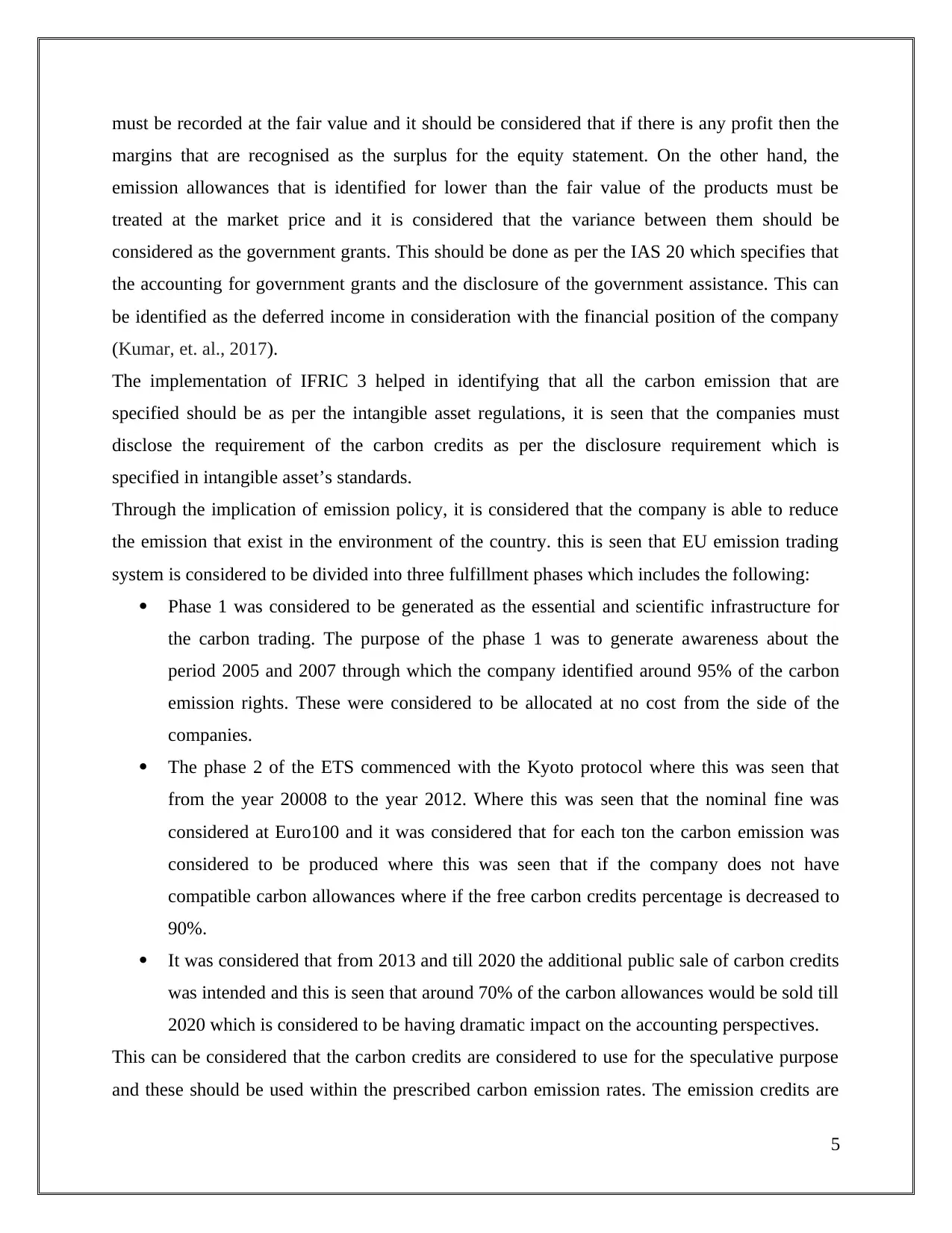
must be recorded at the fair value and it should be considered that if there is any profit then the
margins that are recognised as the surplus for the equity statement. On the other hand, the
emission allowances that is identified for lower than the fair value of the products must be
treated at the market price and it is considered that the variance between them should be
considered as the government grants. This should be done as per the IAS 20 which specifies that
the accounting for government grants and the disclosure of the government assistance. This can
be identified as the deferred income in consideration with the financial position of the company
(Kumar, et. al., 2017).
The implementation of IFRIC 3 helped in identifying that all the carbon emission that are
specified should be as per the intangible asset regulations, it is seen that the companies must
disclose the requirement of the carbon credits as per the disclosure requirement which is
specified in intangible asset’s standards.
Through the implication of emission policy, it is considered that the company is able to reduce
the emission that exist in the environment of the country. this is seen that EU emission trading
system is considered to be divided into three fulfillment phases which includes the following:
Phase 1 was considered to be generated as the essential and scientific infrastructure for
the carbon trading. The purpose of the phase 1 was to generate awareness about the
period 2005 and 2007 through which the company identified around 95% of the carbon
emission rights. These were considered to be allocated at no cost from the side of the
companies.
The phase 2 of the ETS commenced with the Kyoto protocol where this was seen that
from the year 20008 to the year 2012. Where this was seen that the nominal fine was
considered at Euro100 and it was considered that for each ton the carbon emission was
considered to be produced where this was seen that if the company does not have
compatible carbon allowances where if the free carbon credits percentage is decreased to
90%.
It was considered that from 2013 and till 2020 the additional public sale of carbon credits
was intended and this is seen that around 70% of the carbon allowances would be sold till
2020 which is considered to be having dramatic impact on the accounting perspectives.
This can be considered that the carbon credits are considered to use for the speculative purpose
and these should be used within the prescribed carbon emission rates. The emission credits are
5
margins that are recognised as the surplus for the equity statement. On the other hand, the
emission allowances that is identified for lower than the fair value of the products must be
treated at the market price and it is considered that the variance between them should be
considered as the government grants. This should be done as per the IAS 20 which specifies that
the accounting for government grants and the disclosure of the government assistance. This can
be identified as the deferred income in consideration with the financial position of the company
(Kumar, et. al., 2017).
The implementation of IFRIC 3 helped in identifying that all the carbon emission that are
specified should be as per the intangible asset regulations, it is seen that the companies must
disclose the requirement of the carbon credits as per the disclosure requirement which is
specified in intangible asset’s standards.
Through the implication of emission policy, it is considered that the company is able to reduce
the emission that exist in the environment of the country. this is seen that EU emission trading
system is considered to be divided into three fulfillment phases which includes the following:
Phase 1 was considered to be generated as the essential and scientific infrastructure for
the carbon trading. The purpose of the phase 1 was to generate awareness about the
period 2005 and 2007 through which the company identified around 95% of the carbon
emission rights. These were considered to be allocated at no cost from the side of the
companies.
The phase 2 of the ETS commenced with the Kyoto protocol where this was seen that
from the year 20008 to the year 2012. Where this was seen that the nominal fine was
considered at Euro100 and it was considered that for each ton the carbon emission was
considered to be produced where this was seen that if the company does not have
compatible carbon allowances where if the free carbon credits percentage is decreased to
90%.
It was considered that from 2013 and till 2020 the additional public sale of carbon credits
was intended and this is seen that around 70% of the carbon allowances would be sold till
2020 which is considered to be having dramatic impact on the accounting perspectives.
This can be considered that the carbon credits are considered to use for the speculative purpose
and these should be used within the prescribed carbon emission rates. The emission credits are
5
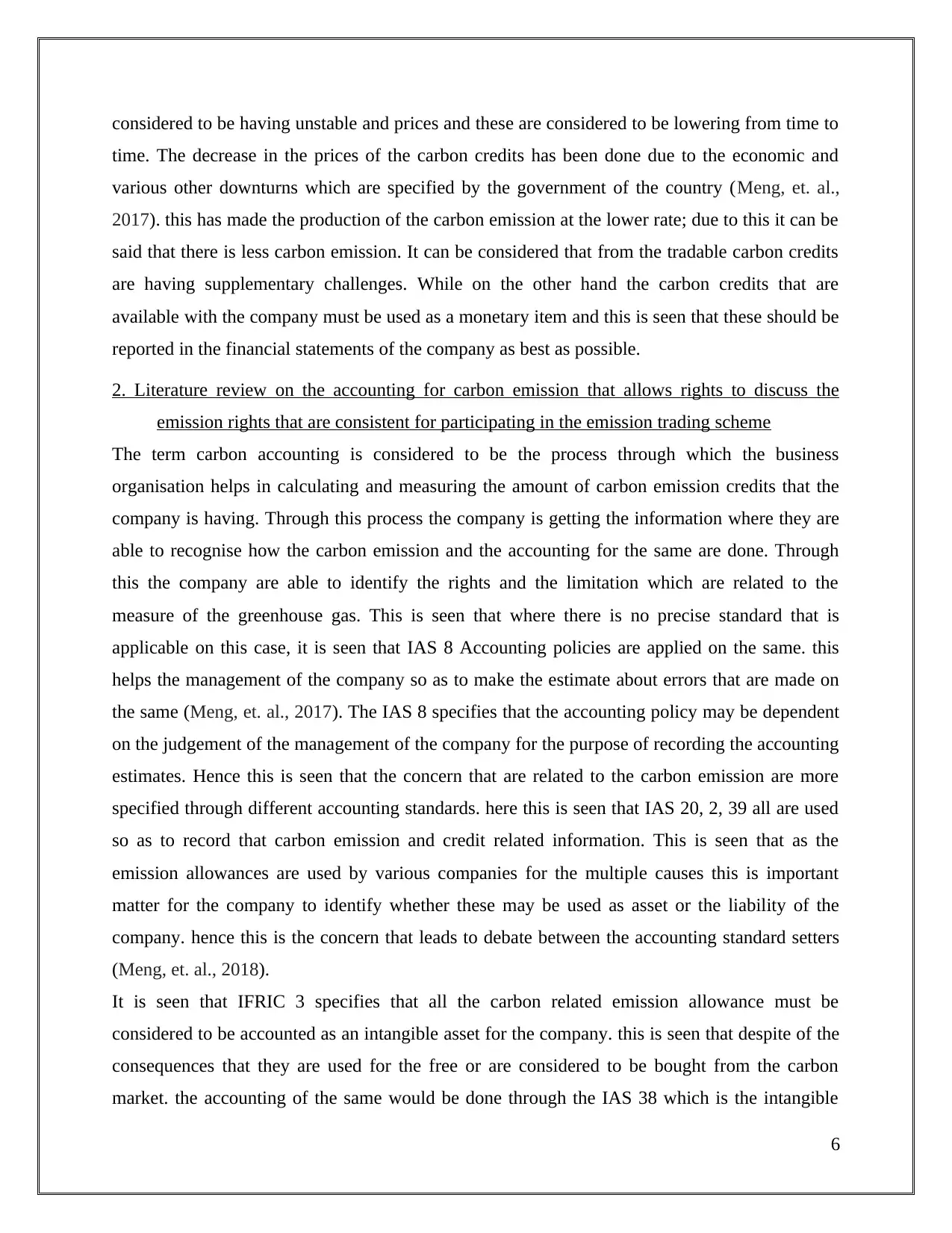
considered to be having unstable and prices and these are considered to be lowering from time to
time. The decrease in the prices of the carbon credits has been done due to the economic and
various other downturns which are specified by the government of the country (Meng, et. al.,
2017). this has made the production of the carbon emission at the lower rate; due to this it can be
said that there is less carbon emission. It can be considered that from the tradable carbon credits
are having supplementary challenges. While on the other hand the carbon credits that are
available with the company must be used as a monetary item and this is seen that these should be
reported in the financial statements of the company as best as possible.
2. Literature review on the accounting for carbon emission that allows rights to discuss the
emission rights that are consistent for participating in the emission trading scheme
The term carbon accounting is considered to be the process through which the business
organisation helps in calculating and measuring the amount of carbon emission credits that the
company is having. Through this process the company is getting the information where they are
able to recognise how the carbon emission and the accounting for the same are done. Through
this the company are able to identify the rights and the limitation which are related to the
measure of the greenhouse gas. This is seen that where there is no precise standard that is
applicable on this case, it is seen that IAS 8 Accounting policies are applied on the same. this
helps the management of the company so as to make the estimate about errors that are made on
the same (Meng, et. al., 2017). The IAS 8 specifies that the accounting policy may be dependent
on the judgement of the management of the company for the purpose of recording the accounting
estimates. Hence this is seen that the concern that are related to the carbon emission are more
specified through different accounting standards. here this is seen that IAS 20, 2, 39 all are used
so as to record that carbon emission and credit related information. This is seen that as the
emission allowances are used by various companies for the multiple causes this is important
matter for the company to identify whether these may be used as asset or the liability of the
company. hence this is the concern that leads to debate between the accounting standard setters
(Meng, et. al., 2018).
It is seen that IFRIC 3 specifies that all the carbon related emission allowance must be
considered to be accounted as an intangible asset for the company. this is seen that despite of the
consequences that they are used for the free or are considered to be bought from the carbon
market. the accounting of the same would be done through the IAS 38 which is the intangible
6
time. The decrease in the prices of the carbon credits has been done due to the economic and
various other downturns which are specified by the government of the country (Meng, et. al.,
2017). this has made the production of the carbon emission at the lower rate; due to this it can be
said that there is less carbon emission. It can be considered that from the tradable carbon credits
are having supplementary challenges. While on the other hand the carbon credits that are
available with the company must be used as a monetary item and this is seen that these should be
reported in the financial statements of the company as best as possible.
2. Literature review on the accounting for carbon emission that allows rights to discuss the
emission rights that are consistent for participating in the emission trading scheme
The term carbon accounting is considered to be the process through which the business
organisation helps in calculating and measuring the amount of carbon emission credits that the
company is having. Through this process the company is getting the information where they are
able to recognise how the carbon emission and the accounting for the same are done. Through
this the company are able to identify the rights and the limitation which are related to the
measure of the greenhouse gas. This is seen that where there is no precise standard that is
applicable on this case, it is seen that IAS 8 Accounting policies are applied on the same. this
helps the management of the company so as to make the estimate about errors that are made on
the same (Meng, et. al., 2017). The IAS 8 specifies that the accounting policy may be dependent
on the judgement of the management of the company for the purpose of recording the accounting
estimates. Hence this is seen that the concern that are related to the carbon emission are more
specified through different accounting standards. here this is seen that IAS 20, 2, 39 all are used
so as to record that carbon emission and credit related information. This is seen that as the
emission allowances are used by various companies for the multiple causes this is important
matter for the company to identify whether these may be used as asset or the liability of the
company. hence this is the concern that leads to debate between the accounting standard setters
(Meng, et. al., 2018).
It is seen that IFRIC 3 specifies that all the carbon related emission allowance must be
considered to be accounted as an intangible asset for the company. this is seen that despite of the
consequences that they are used for the free or are considered to be bought from the carbon
market. the accounting of the same would be done through the IAS 38 which is the intangible
6
⊘ This is a preview!⊘
Do you want full access?
Subscribe today to unlock all pages.

Trusted by 1+ million students worldwide
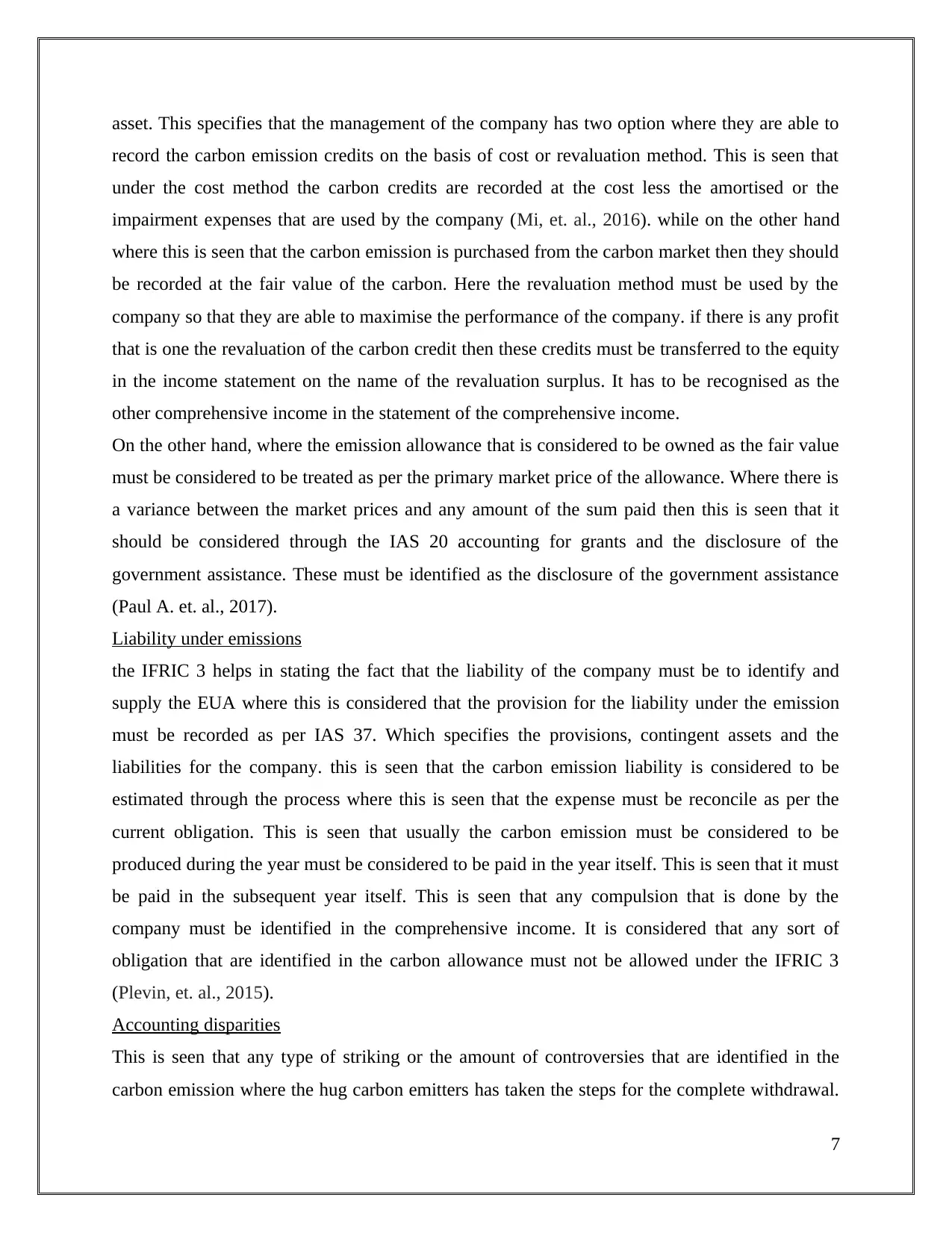
asset. This specifies that the management of the company has two option where they are able to
record the carbon emission credits on the basis of cost or revaluation method. This is seen that
under the cost method the carbon credits are recorded at the cost less the amortised or the
impairment expenses that are used by the company (Mi, et. al., 2016). while on the other hand
where this is seen that the carbon emission is purchased from the carbon market then they should
be recorded at the fair value of the carbon. Here the revaluation method must be used by the
company so that they are able to maximise the performance of the company. if there is any profit
that is one the revaluation of the carbon credit then these credits must be transferred to the equity
in the income statement on the name of the revaluation surplus. It has to be recognised as the
other comprehensive income in the statement of the comprehensive income.
On the other hand, where the emission allowance that is considered to be owned as the fair value
must be considered to be treated as per the primary market price of the allowance. Where there is
a variance between the market prices and any amount of the sum paid then this is seen that it
should be considered through the IAS 20 accounting for grants and the disclosure of the
government assistance. These must be identified as the disclosure of the government assistance
(Paul A. et. al., 2017).
Liability under emissions
the IFRIC 3 helps in stating the fact that the liability of the company must be to identify and
supply the EUA where this is considered that the provision for the liability under the emission
must be recorded as per IAS 37. Which specifies the provisions, contingent assets and the
liabilities for the company. this is seen that the carbon emission liability is considered to be
estimated through the process where this is seen that the expense must be reconcile as per the
current obligation. This is seen that usually the carbon emission must be considered to be
produced during the year must be considered to be paid in the year itself. This is seen that it must
be paid in the subsequent year itself. This is seen that any compulsion that is done by the
company must be identified in the comprehensive income. It is considered that any sort of
obligation that are identified in the carbon allowance must not be allowed under the IFRIC 3
(Plevin, et. al., 2015).
Accounting disparities
This is seen that any type of striking or the amount of controversies that are identified in the
carbon emission where the hug carbon emitters has taken the steps for the complete withdrawal.
7
record the carbon emission credits on the basis of cost or revaluation method. This is seen that
under the cost method the carbon credits are recorded at the cost less the amortised or the
impairment expenses that are used by the company (Mi, et. al., 2016). while on the other hand
where this is seen that the carbon emission is purchased from the carbon market then they should
be recorded at the fair value of the carbon. Here the revaluation method must be used by the
company so that they are able to maximise the performance of the company. if there is any profit
that is one the revaluation of the carbon credit then these credits must be transferred to the equity
in the income statement on the name of the revaluation surplus. It has to be recognised as the
other comprehensive income in the statement of the comprehensive income.
On the other hand, where the emission allowance that is considered to be owned as the fair value
must be considered to be treated as per the primary market price of the allowance. Where there is
a variance between the market prices and any amount of the sum paid then this is seen that it
should be considered through the IAS 20 accounting for grants and the disclosure of the
government assistance. These must be identified as the disclosure of the government assistance
(Paul A. et. al., 2017).
Liability under emissions
the IFRIC 3 helps in stating the fact that the liability of the company must be to identify and
supply the EUA where this is considered that the provision for the liability under the emission
must be recorded as per IAS 37. Which specifies the provisions, contingent assets and the
liabilities for the company. this is seen that the carbon emission liability is considered to be
estimated through the process where this is seen that the expense must be reconcile as per the
current obligation. This is seen that usually the carbon emission must be considered to be
produced during the year must be considered to be paid in the year itself. This is seen that it must
be paid in the subsequent year itself. This is seen that any compulsion that is done by the
company must be identified in the comprehensive income. It is considered that any sort of
obligation that are identified in the carbon allowance must not be allowed under the IFRIC 3
(Plevin, et. al., 2015).
Accounting disparities
This is seen that any type of striking or the amount of controversies that are identified in the
carbon emission where the hug carbon emitters has taken the steps for the complete withdrawal.
7
Paraphrase This Document
Need a fresh take? Get an instant paraphrase of this document with our AI Paraphraser
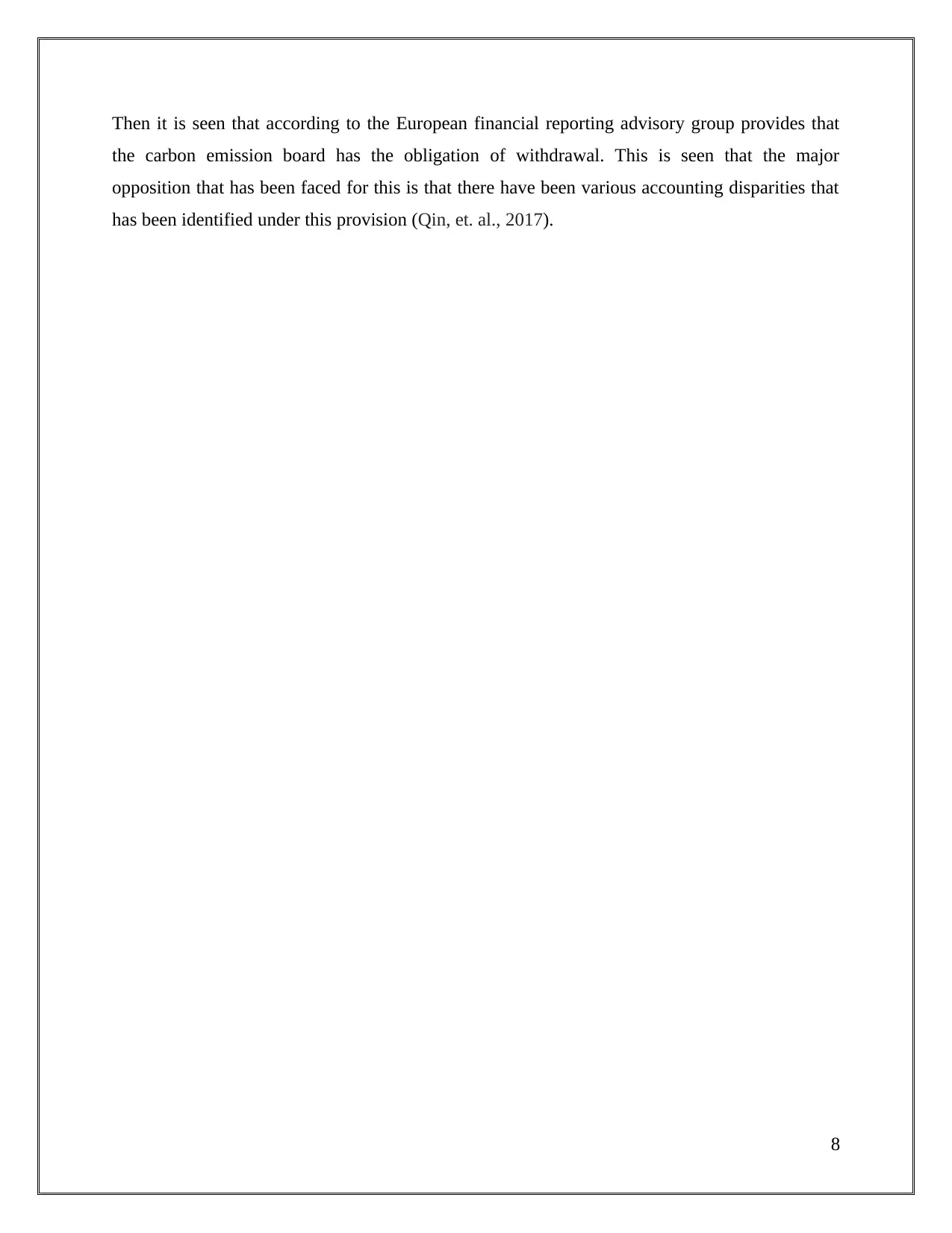
Then it is seen that according to the European financial reporting advisory group provides that
the carbon emission board has the obligation of withdrawal. This is seen that the major
opposition that has been faced for this is that there have been various accounting disparities that
has been identified under this provision (Qin, et. al., 2017).
8
the carbon emission board has the obligation of withdrawal. This is seen that the major
opposition that has been faced for this is that there have been various accounting disparities that
has been identified under this provision (Qin, et. al., 2017).
8
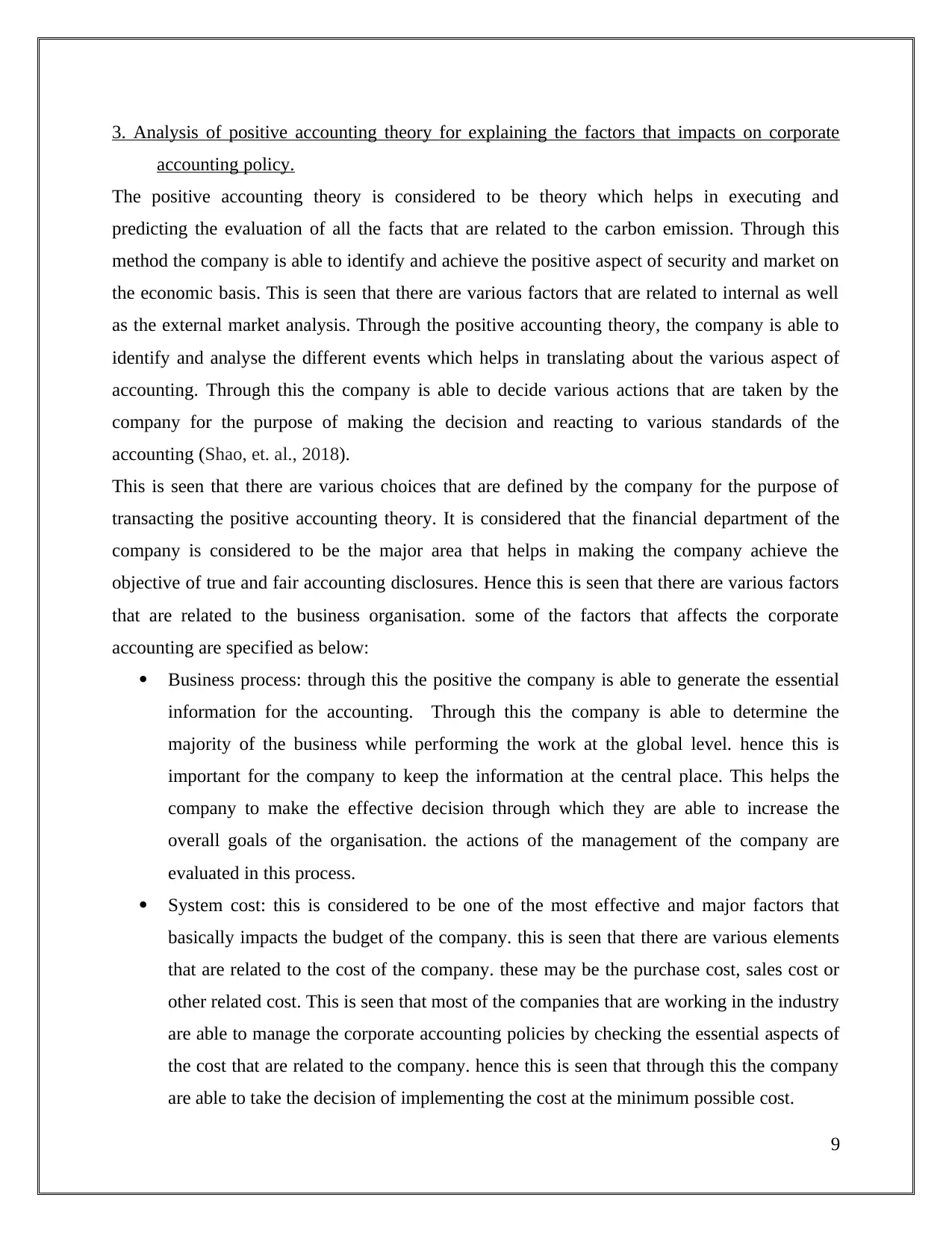
3. Analysis of positive accounting theory for explaining the factors that impacts on corporate
accounting policy.
The positive accounting theory is considered to be theory which helps in executing and
predicting the evaluation of all the facts that are related to the carbon emission. Through this
method the company is able to identify and achieve the positive aspect of security and market on
the economic basis. This is seen that there are various factors that are related to internal as well
as the external market analysis. Through the positive accounting theory, the company is able to
identify and analyse the different events which helps in translating about the various aspect of
accounting. Through this the company is able to decide various actions that are taken by the
company for the purpose of making the decision and reacting to various standards of the
accounting (Shao, et. al., 2018).
This is seen that there are various choices that are defined by the company for the purpose of
transacting the positive accounting theory. It is considered that the financial department of the
company is considered to be the major area that helps in making the company achieve the
objective of true and fair accounting disclosures. Hence this is seen that there are various factors
that are related to the business organisation. some of the factors that affects the corporate
accounting are specified as below:
Business process: through this the positive the company is able to generate the essential
information for the accounting. Through this the company is able to determine the
majority of the business while performing the work at the global level. hence this is
important for the company to keep the information at the central place. This helps the
company to make the effective decision through which they are able to increase the
overall goals of the organisation. the actions of the management of the company are
evaluated in this process.
System cost: this is considered to be one of the most effective and major factors that
basically impacts the budget of the company. this is seen that there are various elements
that are related to the cost of the company. these may be the purchase cost, sales cost or
other related cost. This is seen that most of the companies that are working in the industry
are able to manage the corporate accounting policies by checking the essential aspects of
the cost that are related to the company. hence this is seen that through this the company
are able to take the decision of implementing the cost at the minimum possible cost.
9
accounting policy.
The positive accounting theory is considered to be theory which helps in executing and
predicting the evaluation of all the facts that are related to the carbon emission. Through this
method the company is able to identify and achieve the positive aspect of security and market on
the economic basis. This is seen that there are various factors that are related to internal as well
as the external market analysis. Through the positive accounting theory, the company is able to
identify and analyse the different events which helps in translating about the various aspect of
accounting. Through this the company is able to decide various actions that are taken by the
company for the purpose of making the decision and reacting to various standards of the
accounting (Shao, et. al., 2018).
This is seen that there are various choices that are defined by the company for the purpose of
transacting the positive accounting theory. It is considered that the financial department of the
company is considered to be the major area that helps in making the company achieve the
objective of true and fair accounting disclosures. Hence this is seen that there are various factors
that are related to the business organisation. some of the factors that affects the corporate
accounting are specified as below:
Business process: through this the positive the company is able to generate the essential
information for the accounting. Through this the company is able to determine the
majority of the business while performing the work at the global level. hence this is
important for the company to keep the information at the central place. This helps the
company to make the effective decision through which they are able to increase the
overall goals of the organisation. the actions of the management of the company are
evaluated in this process.
System cost: this is considered to be one of the most effective and major factors that
basically impacts the budget of the company. this is seen that there are various elements
that are related to the cost of the company. these may be the purchase cost, sales cost or
other related cost. This is seen that most of the companies that are working in the industry
are able to manage the corporate accounting policies by checking the essential aspects of
the cost that are related to the company. hence this is seen that through this the company
are able to take the decision of implementing the cost at the minimum possible cost.
9
⊘ This is a preview!⊘
Do you want full access?
Subscribe today to unlock all pages.

Trusted by 1+ million students worldwide
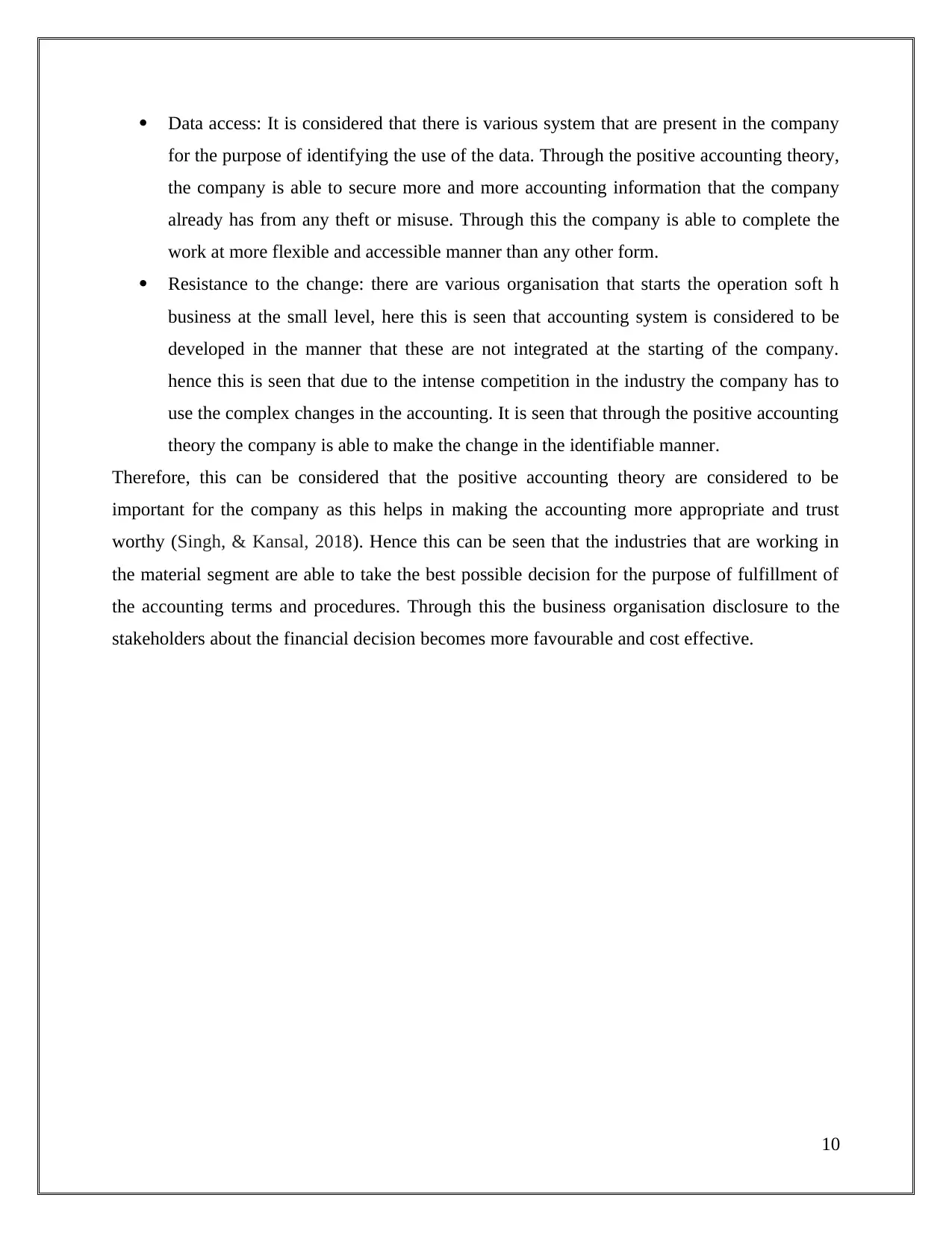
Data access: It is considered that there is various system that are present in the company
for the purpose of identifying the use of the data. Through the positive accounting theory,
the company is able to secure more and more accounting information that the company
already has from any theft or misuse. Through this the company is able to complete the
work at more flexible and accessible manner than any other form.
Resistance to the change: there are various organisation that starts the operation soft h
business at the small level, here this is seen that accounting system is considered to be
developed in the manner that these are not integrated at the starting of the company.
hence this is seen that due to the intense competition in the industry the company has to
use the complex changes in the accounting. It is seen that through the positive accounting
theory the company is able to make the change in the identifiable manner.
Therefore, this can be considered that the positive accounting theory are considered to be
important for the company as this helps in making the accounting more appropriate and trust
worthy (Singh, & Kansal, 2018). Hence this can be seen that the industries that are working in
the material segment are able to take the best possible decision for the purpose of fulfillment of
the accounting terms and procedures. Through this the business organisation disclosure to the
stakeholders about the financial decision becomes more favourable and cost effective.
10
for the purpose of identifying the use of the data. Through the positive accounting theory,
the company is able to secure more and more accounting information that the company
already has from any theft or misuse. Through this the company is able to complete the
work at more flexible and accessible manner than any other form.
Resistance to the change: there are various organisation that starts the operation soft h
business at the small level, here this is seen that accounting system is considered to be
developed in the manner that these are not integrated at the starting of the company.
hence this is seen that due to the intense competition in the industry the company has to
use the complex changes in the accounting. It is seen that through the positive accounting
theory the company is able to make the change in the identifiable manner.
Therefore, this can be considered that the positive accounting theory are considered to be
important for the company as this helps in making the accounting more appropriate and trust
worthy (Singh, & Kansal, 2018). Hence this can be seen that the industries that are working in
the material segment are able to take the best possible decision for the purpose of fulfillment of
the accounting terms and procedures. Through this the business organisation disclosure to the
stakeholders about the financial decision becomes more favourable and cost effective.
10
Paraphrase This Document
Need a fresh take? Get an instant paraphrase of this document with our AI Paraphraser
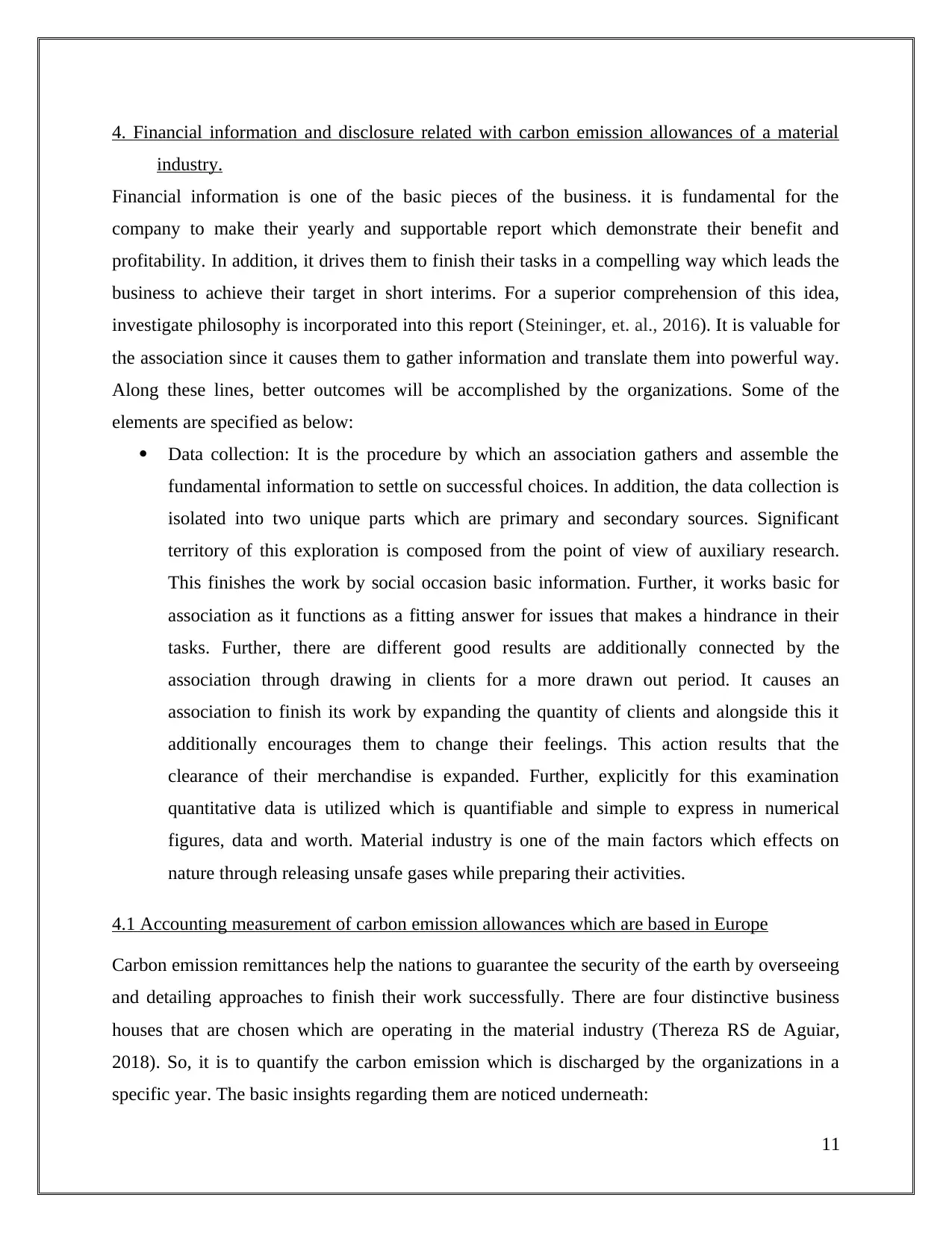
4. Financial information and disclosure related with carbon emission allowances of a material
industry.
Financial information is one of the basic pieces of the business. it is fundamental for the
company to make their yearly and supportable report which demonstrate their benefit and
profitability. In addition, it drives them to finish their tasks in a compelling way which leads the
business to achieve their target in short interims. For a superior comprehension of this idea,
investigate philosophy is incorporated into this report (Steininger, et. al., 2016). It is valuable for
the association since it causes them to gather information and translate them into powerful way.
Along these lines, better outcomes will be accomplished by the organizations. Some of the
elements are specified as below:
Data collection: It is the procedure by which an association gathers and assemble the
fundamental information to settle on successful choices. In addition, the data collection is
isolated into two unique parts which are primary and secondary sources. Significant
territory of this exploration is composed from the point of view of auxiliary research.
This finishes the work by social occasion basic information. Further, it works basic for
association as it functions as a fitting answer for issues that makes a hindrance in their
tasks. Further, there are different good results are additionally connected by the
association through drawing in clients for a more drawn out period. It causes an
association to finish its work by expanding the quantity of clients and alongside this it
additionally encourages them to change their feelings. This action results that the
clearance of their merchandise is expanded. Further, explicitly for this examination
quantitative data is utilized which is quantifiable and simple to express in numerical
figures, data and worth. Material industry is one of the main factors which effects on
nature through releasing unsafe gases while preparing their activities.
4.1 Accounting measurement of carbon emission allowances which are based in Europe
Carbon emission remittances help the nations to guarantee the security of the earth by overseeing
and detailing approaches to finish their work successfully. There are four distinctive business
houses that are chosen which are operating in the material industry (Thereza RS de Aguiar,
2018). So, it is to quantify the carbon emission which is discharged by the organizations in a
specific year. The basic insights regarding them are noticed underneath:
11
industry.
Financial information is one of the basic pieces of the business. it is fundamental for the
company to make their yearly and supportable report which demonstrate their benefit and
profitability. In addition, it drives them to finish their tasks in a compelling way which leads the
business to achieve their target in short interims. For a superior comprehension of this idea,
investigate philosophy is incorporated into this report (Steininger, et. al., 2016). It is valuable for
the association since it causes them to gather information and translate them into powerful way.
Along these lines, better outcomes will be accomplished by the organizations. Some of the
elements are specified as below:
Data collection: It is the procedure by which an association gathers and assemble the
fundamental information to settle on successful choices. In addition, the data collection is
isolated into two unique parts which are primary and secondary sources. Significant
territory of this exploration is composed from the point of view of auxiliary research.
This finishes the work by social occasion basic information. Further, it works basic for
association as it functions as a fitting answer for issues that makes a hindrance in their
tasks. Further, there are different good results are additionally connected by the
association through drawing in clients for a more drawn out period. It causes an
association to finish its work by expanding the quantity of clients and alongside this it
additionally encourages them to change their feelings. This action results that the
clearance of their merchandise is expanded. Further, explicitly for this examination
quantitative data is utilized which is quantifiable and simple to express in numerical
figures, data and worth. Material industry is one of the main factors which effects on
nature through releasing unsafe gases while preparing their activities.
4.1 Accounting measurement of carbon emission allowances which are based in Europe
Carbon emission remittances help the nations to guarantee the security of the earth by overseeing
and detailing approaches to finish their work successfully. There are four distinctive business
houses that are chosen which are operating in the material industry (Thereza RS de Aguiar,
2018). So, it is to quantify the carbon emission which is discharged by the organizations in a
specific year. The basic insights regarding them are noticed underneath:
11
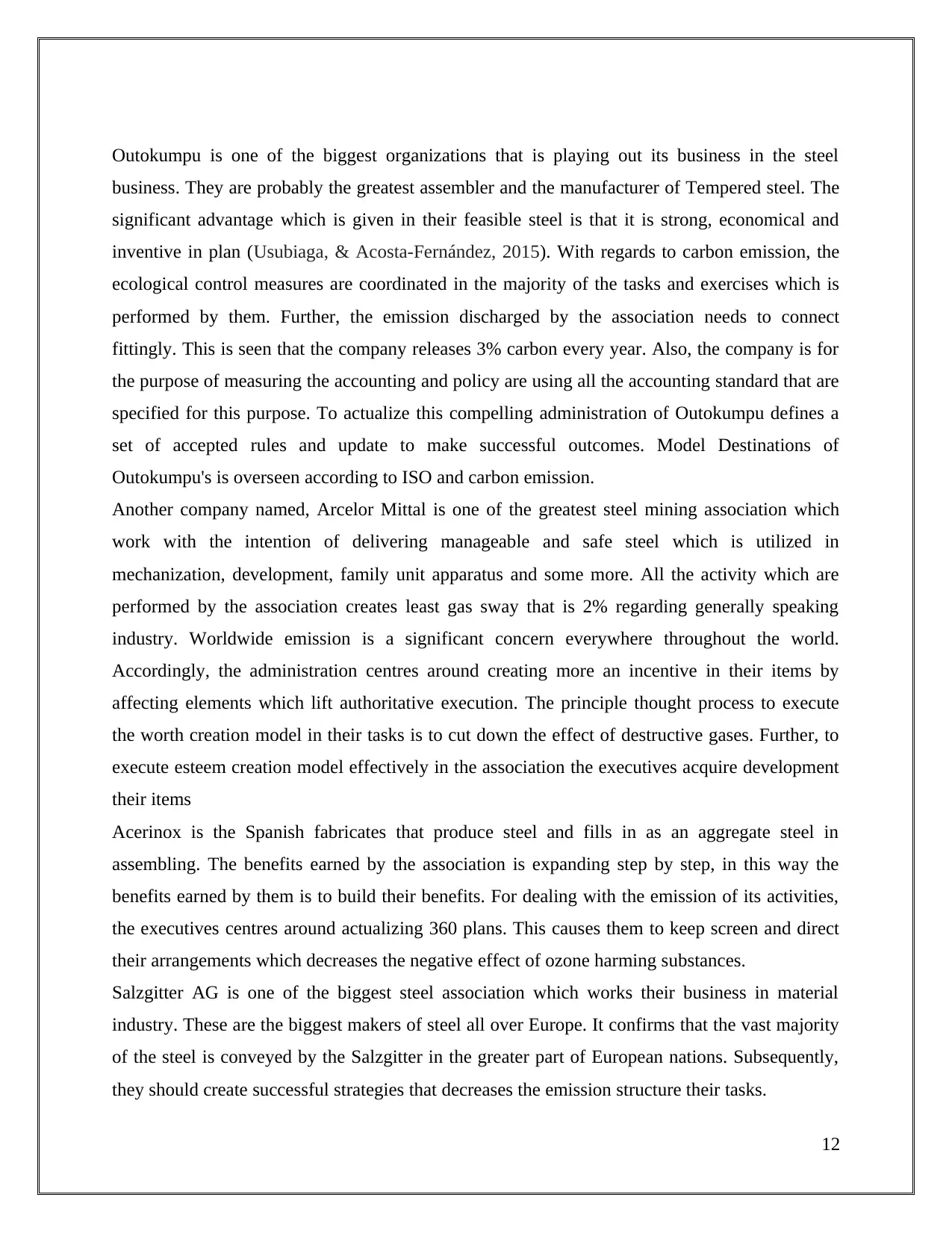
Outokumpu is one of the biggest organizations that is playing out its business in the steel
business. They are probably the greatest assembler and the manufacturer of Tempered steel. The
significant advantage which is given in their feasible steel is that it is strong, economical and
inventive in plan (Usubiaga, & Acosta-Fernández, 2015). With regards to carbon emission, the
ecological control measures are coordinated in the majority of the tasks and exercises which is
performed by them. Further, the emission discharged by the association needs to connect
fittingly. This is seen that the company releases 3% carbon every year. Also, the company is for
the purpose of measuring the accounting and policy are using all the accounting standard that are
specified for this purpose. To actualize this compelling administration of Outokumpu defines a
set of accepted rules and update to make successful outcomes. Model Destinations of
Outokumpu's is overseen according to ISO and carbon emission.
Another company named, Arcelor Mittal is one of the greatest steel mining association which
work with the intention of delivering manageable and safe steel which is utilized in
mechanization, development, family unit apparatus and some more. All the activity which are
performed by the association creates least gas sway that is 2% regarding generally speaking
industry. Worldwide emission is a significant concern everywhere throughout the world.
Accordingly, the administration centres around creating more an incentive in their items by
affecting elements which lift authoritative execution. The principle thought process to execute
the worth creation model in their tasks is to cut down the effect of destructive gases. Further, to
execute esteem creation model effectively in the association the executives acquire development
their items
Acerinox is the Spanish fabricates that produce steel and fills in as an aggregate steel in
assembling. The benefits earned by the association is expanding step by step, in this way the
benefits earned by them is to build their benefits. For dealing with the emission of its activities,
the executives centres around actualizing 360 plans. This causes them to keep screen and direct
their arrangements which decreases the negative effect of ozone harming substances.
Salzgitter AG is one of the biggest steel association which works their business in material
industry. These are the biggest makers of steel all over Europe. It confirms that the vast majority
of the steel is conveyed by the Salzgitter in the greater part of European nations. Subsequently,
they should create successful strategies that decreases the emission structure their tasks.
12
business. They are probably the greatest assembler and the manufacturer of Tempered steel. The
significant advantage which is given in their feasible steel is that it is strong, economical and
inventive in plan (Usubiaga, & Acosta-Fernández, 2015). With regards to carbon emission, the
ecological control measures are coordinated in the majority of the tasks and exercises which is
performed by them. Further, the emission discharged by the association needs to connect
fittingly. This is seen that the company releases 3% carbon every year. Also, the company is for
the purpose of measuring the accounting and policy are using all the accounting standard that are
specified for this purpose. To actualize this compelling administration of Outokumpu defines a
set of accepted rules and update to make successful outcomes. Model Destinations of
Outokumpu's is overseen according to ISO and carbon emission.
Another company named, Arcelor Mittal is one of the greatest steel mining association which
work with the intention of delivering manageable and safe steel which is utilized in
mechanization, development, family unit apparatus and some more. All the activity which are
performed by the association creates least gas sway that is 2% regarding generally speaking
industry. Worldwide emission is a significant concern everywhere throughout the world.
Accordingly, the administration centres around creating more an incentive in their items by
affecting elements which lift authoritative execution. The principle thought process to execute
the worth creation model in their tasks is to cut down the effect of destructive gases. Further, to
execute esteem creation model effectively in the association the executives acquire development
their items
Acerinox is the Spanish fabricates that produce steel and fills in as an aggregate steel in
assembling. The benefits earned by the association is expanding step by step, in this way the
benefits earned by them is to build their benefits. For dealing with the emission of its activities,
the executives centres around actualizing 360 plans. This causes them to keep screen and direct
their arrangements which decreases the negative effect of ozone harming substances.
Salzgitter AG is one of the biggest steel association which works their business in material
industry. These are the biggest makers of steel all over Europe. It confirms that the vast majority
of the steel is conveyed by the Salzgitter in the greater part of European nations. Subsequently,
they should create successful strategies that decreases the emission structure their tasks.
12
⊘ This is a preview!⊘
Do you want full access?
Subscribe today to unlock all pages.

Trusted by 1+ million students worldwide
1 out of 17
Related Documents
Your All-in-One AI-Powered Toolkit for Academic Success.
+13062052269
info@desklib.com
Available 24*7 on WhatsApp / Email
![[object Object]](/_next/static/media/star-bottom.7253800d.svg)
Unlock your academic potential
Copyright © 2020–2025 A2Z Services. All Rights Reserved. Developed and managed by ZUCOL.





